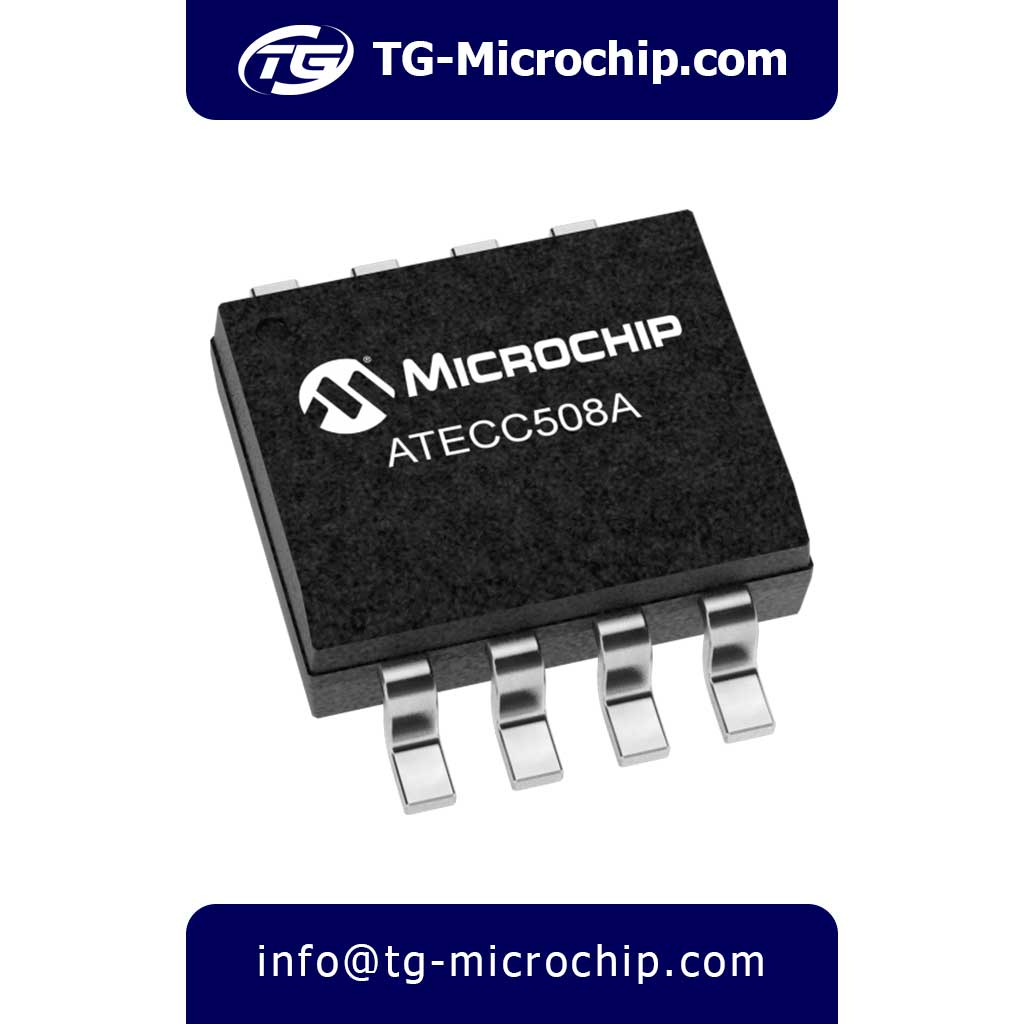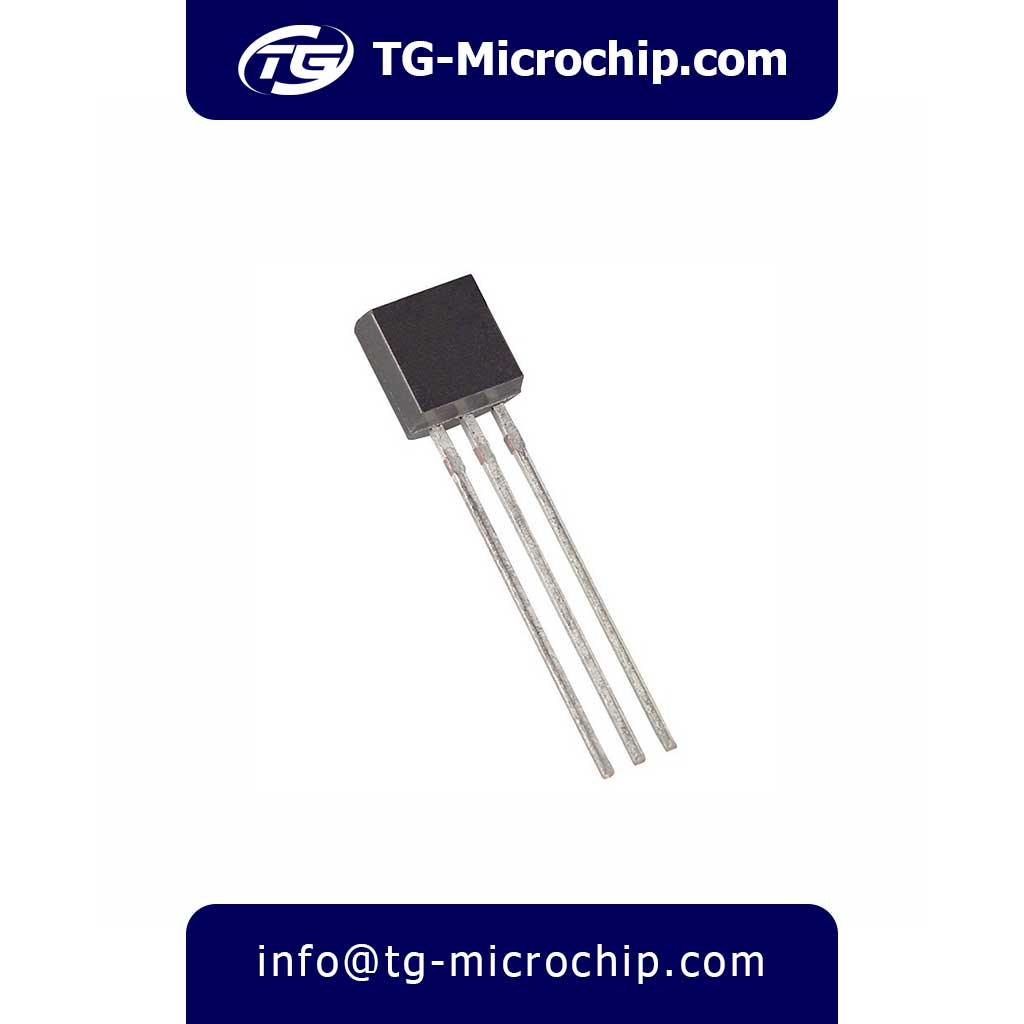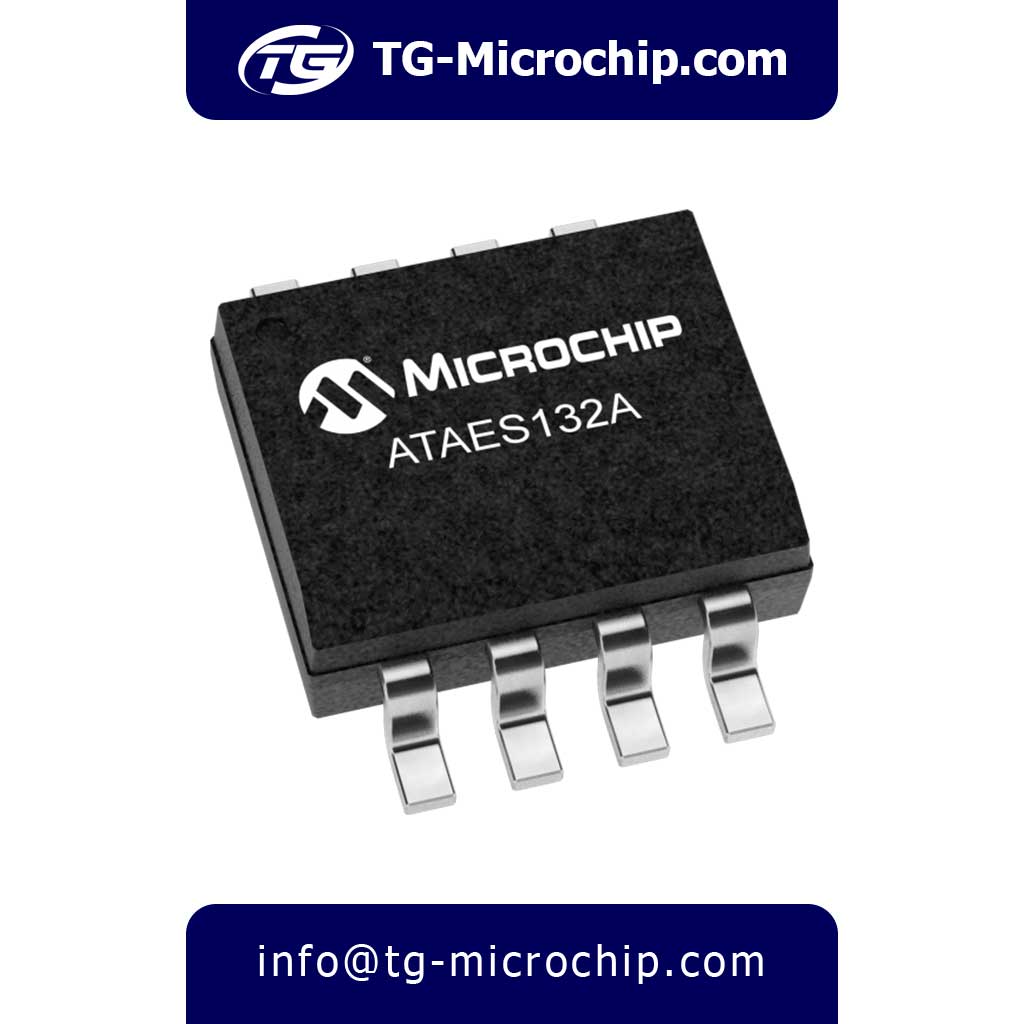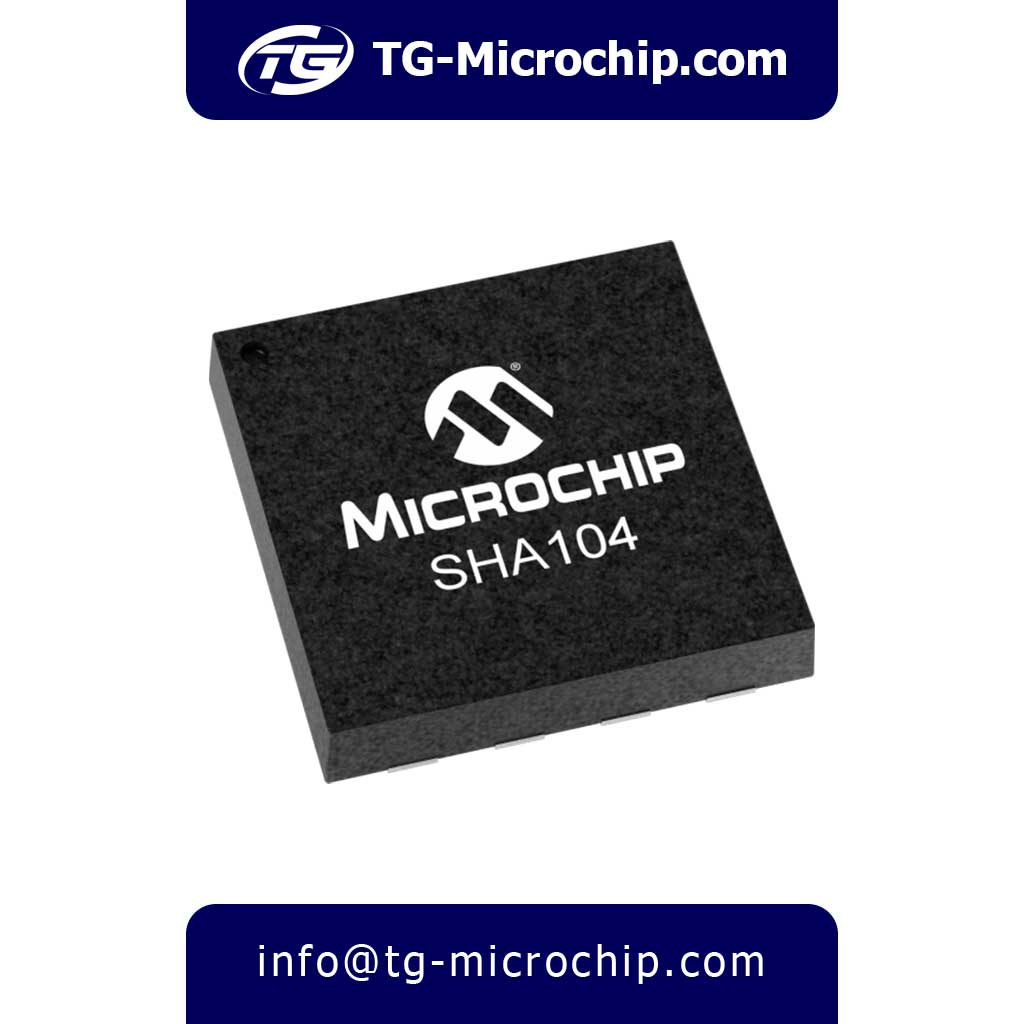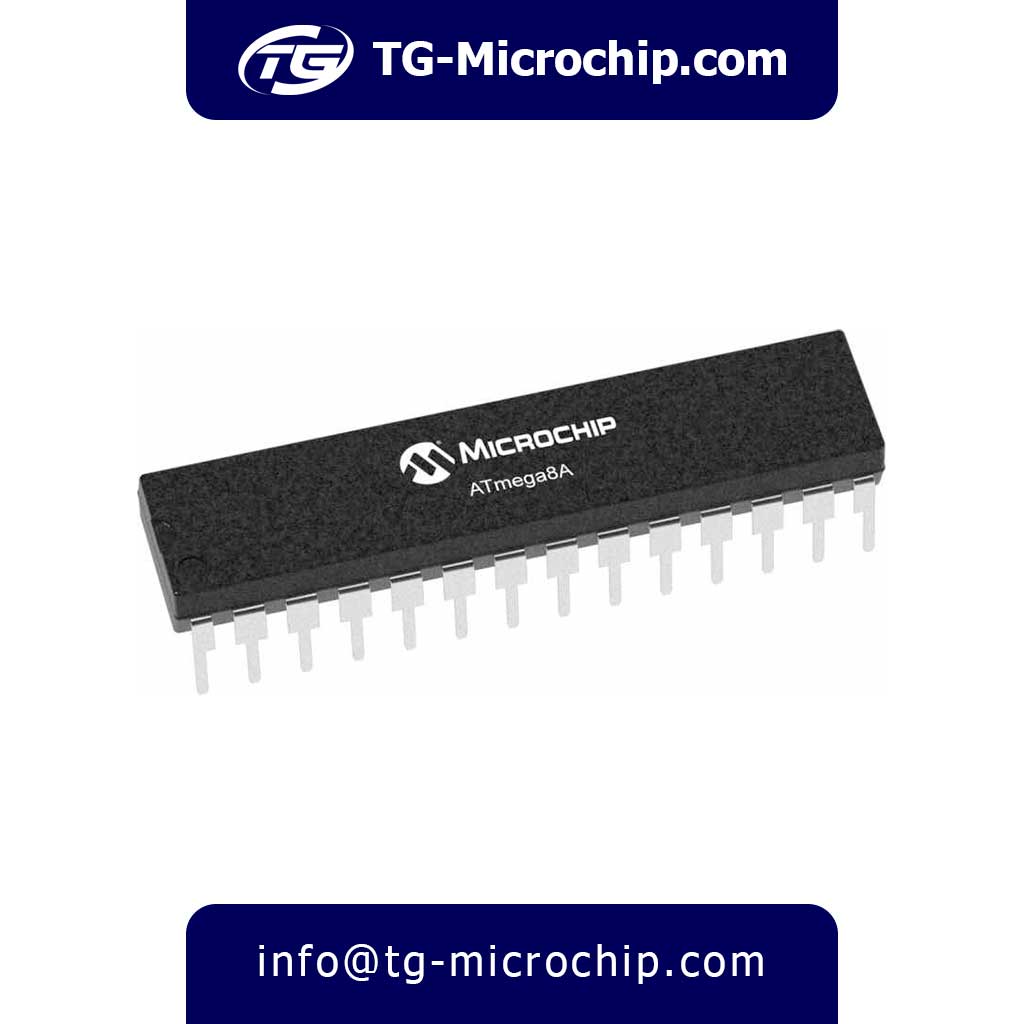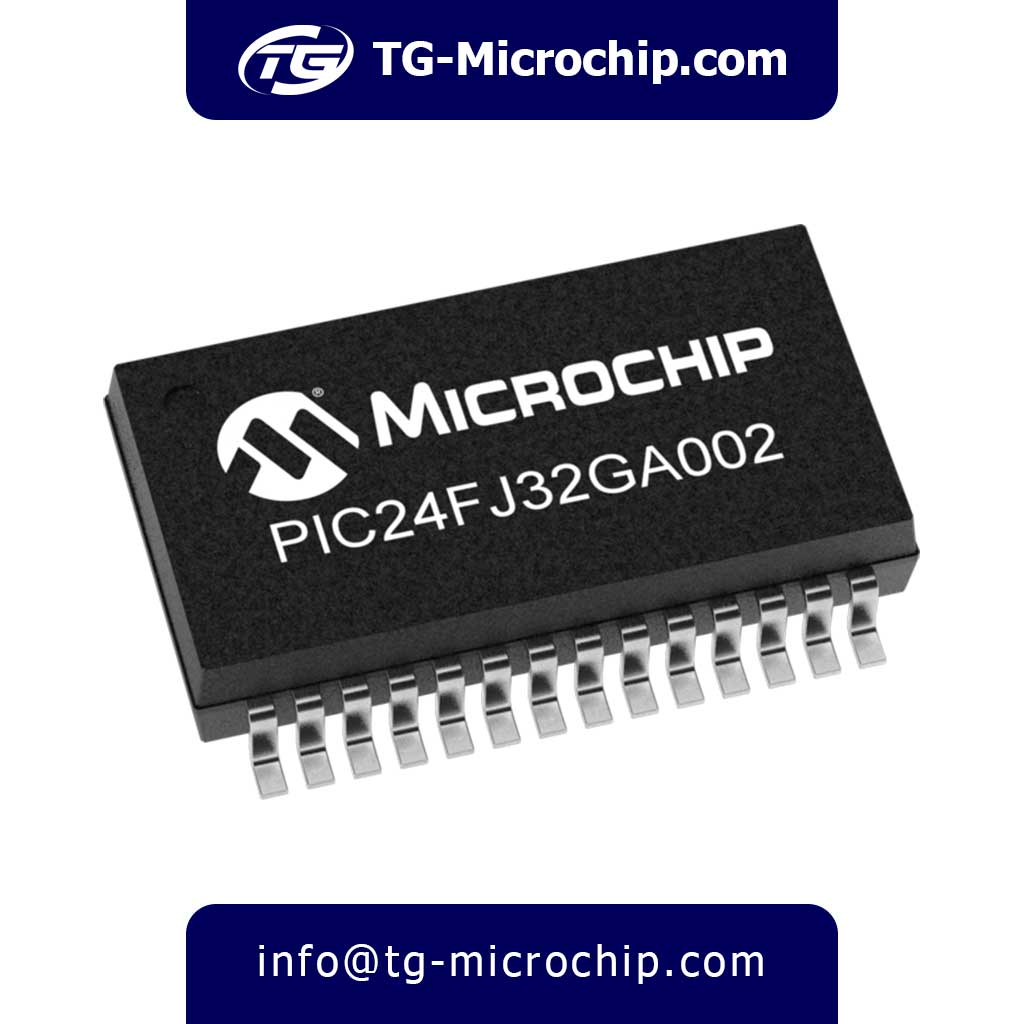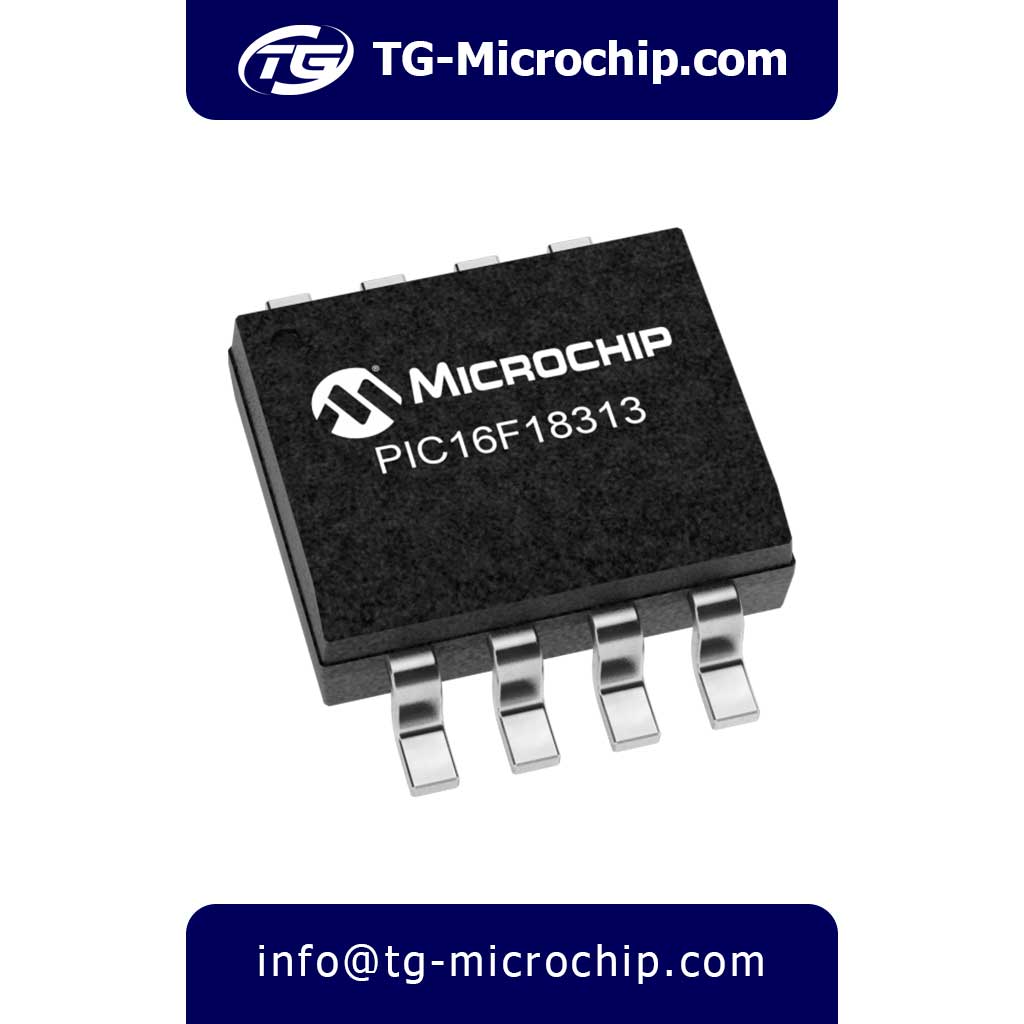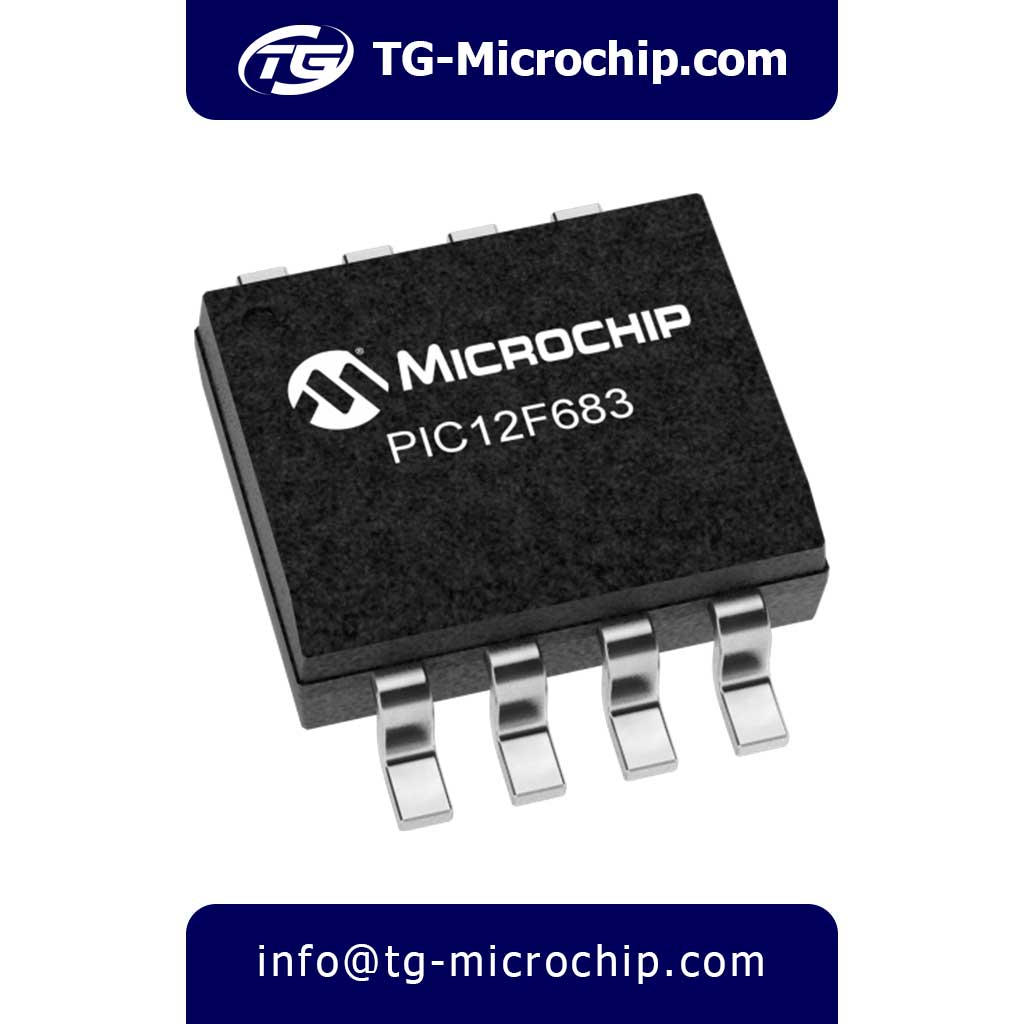For order or price inquiry of ATECC508A-SSHDA-T Microchip Technology Please click on Buy Order button and fill the RFQ form we will check out inventory and offer you our best price.
Quick Access
About
The ATECC508A-SSHDA-T by Microchip Technology is a high-security cryptographic authentication chip designed for embedded systems requiring robust protection against counterfeiting, cloning, and unauthorized access. Housed in an SOIC-8 package, this device integrates Elliptic Curve Cryptography (ECC) with NIST P-256 support, enabling secure key generation, storage, and authentication. It operates across a wide voltage range (2.0V–5.5V) and features ultra-low power consumption (<150 nA in sleep mode), making it ideal for battery-powered IoT devices. With interfaces including I²C (up to 1 MHz), SPI (up to 10 MHz), and 1-Wire, it offers flexible integration into diverse embedded systems.
Security is at the core of the ATECC508A, which includes hardware-accelerated AES-128, SHA-256, and HMAC-256 for encryption and authentication. The chip ensures secure key storage with tamper-resistant features such as active shielding, glitch detection, and automatic zeroization upon tamper detection. It also supports secure boot, mutual authentication, and anti-cloning measures, making it suitable for applications like secure firmware updates, payment terminals, and industrial control systems. With 10 KB of EEPROM and 512-bit OTP memory, it provides ample secure storage for cryptographic keys and certificates.
Designed for industrial environments, the ATECC508A operates reliably in -40°C to +85°C temperatures and meets stringent security certifications, including FIPS 140-2/3 and Common Criteria EAL4+. Its 20+ years of data retention and 100,000 write cycles ensure long-term reliability in demanding applications. The chip is RoHS-compliant and available in tube or tape-and-reel packaging, catering to both prototyping and mass production needs. Microchip provides development tools like CryptoAuthLib and the AT88CKECC kit, simplifying integration into secure systems.
Target applications include IoT device authentication, medical equipment, smart meters, and supply chain security, where preventing unauthorized access is critical. By offloading cryptographic operations to a dedicated secure element, the ATECC508A enhances system security while reducing the burden on the host microcontroller. Its combination of low power, robust security, and ease of integration makes it a preferred choice for developers building tamper-resistant embedded solutions. For detailed implementation, Microchip offers extensive datasheets, application notes, and SDK support to streamline deployment.
Key Features
1. Hardware-Based Security
- Secure Element Architecture
- Dedicated crypto processor isolated from host MCU
- All cryptographic operations occur on-chip (keys never exposed)
- Military-Grade Protection
- Active shielding mesh against physical attacks
- Voltage/clock/frequency tamper detection
- Instant zeroization upon tamper events
2. Cryptographic Acceleration
- ECC P-256 (NIST Standard)
- 18ms ECDSA signature generation
- Full support for key agreement (ECDH)
- Symmetric Crypto
- AES-128 encryption/decryption
- SHA-256 & HMAC-256 hardware acceleration
3. Secure Storage & Key Management
- 10KB Secure EEPROM
- Stores up to 16 cryptographic keys/certificates
- Configurable access permissions (read/write locks)
- 512-bit OTP Memory
- For immutable device identifiers or security policies
4. Ultra-Low Power Operation
- 150nA sleep current (ideal for battery-powered IoT)
- 3.5mA active current (at 1MHz I²C)
- 2.0V–5.5V operating range (3.3V/5V compatible)
5. Flexible Interfaces
- I²C (up to 1MHz) – 7-bit addressing (0xC0–0xC6)
- SPI (up to 10MHz) – Mode 0 supported
- Single-Wire (1-Wire®) – For minimal pin count designs
6. Industrial Robustness
- -40°C to +85°C operating temperature
- 20+ year data retention (EEPROM)
- 100,000 write cycles endurance
7. Certifications & Compliance
- FIPS 140-2/3 (Cert #4399) – Validated cryptographic module
- Common Criteria EAL4+ Ready
- RoHS 3 & REACH compliant
8. Development Ecosystem
- CryptoAuthLib (open-source middleware)
- AT88CKECC Evaluation Kit
- Trust Platform Design Suite for provisioning
9. Anti-Cloning Features
- Unique per-device keys injected during manufacturing
- Secure authentication protocols (ECDSA, HMAC)
10. Application-Ready Solutions
- AWS IoT Core & Azure IoT Hub pre-provisioning options
- Secure boot reference designs for ARM/PIC MCUs
Applications
1. IoT & Embedded Security
- Device Authentication – Secure node-to-node communication in IoT networks
- Secure Cloud Connectivity – AWS IoT, Azure, and Google Cloud authentication
- Sensor Data Protection – Encrypt sensitive data from industrial/environmental sensors
2. Consumer Electronics
- Anti-Counterfeiting – Verify genuine products (e.g., printer cartridges, luxury goods)
- Smart Home Devices – Secure firmware updates for routers, cameras, and hubs
- Wearables – Protect user data in fitness trackers/smartwatches
3. Industrial & Automotive
- Secure Firmware Boot – Prevent unauthorized firmware modifications
- Industrial Control Systems (ICS) – Authenticate PLCs and HMIs
- Automotive ECUs – V2X (Vehicle-to-Everything) communication security
4. Financial & Retail
- Payment Terminals – Secure PIN entry and transaction validation
- POS Systems – EMV/NFC payment authentication
- Cryptocurrency Wallets – Hardware-secured private key storage
5. Medical & Government
- Medical Devices – HIPAA-compliant patient data protection
- Secure ID Cards – Government/military-grade authentication
- Supply Chain Security – Track-and-trace for pharmaceuticals
6. Cloud & Enterprise
- Zero Trust Architecture – Hardware-based device identity verification
- Secure API Access – Authenticate IoT devices to cloud services
Advantages
1. Unmatched Hardware Security
- Dedicated Secure Element – Isolates cryptographic operations from the host MCU, preventing software-based attacks.
- Tamper-Resistant Design – Active shielding, voltage/clock monitors, and zeroization upon tamper detection.
- Secure Key Storage – Private keys are never exposed outside the chip, even during operation.
2. Simplified Compliance & Certification
- Pre-Certified Crypto – FIPS 140-2/3 validated algorithms and Common Criteria EAL4+ ready.
- NIST-Compliant – Supports P-256 ECC, AES-128, and SHA-256 for government/industrial use.
- Reduces Development Time – Eliminates the need for custom security implementations.
3. Low Power & High Efficiency
- Ultra-Low Sleep Current (<150 nA) – Ideal for battery-powered IoT (smart sensors, wearables).
- Hardware Acceleration – Offloads crypto from the main CPU (e.g., ECDSA sign in 20 ms).
- Wide Voltage Range (2.0V–5.5V) – Compatible with 3.3V and 5V systems.
4. Easy Integration
- Multiple Interfaces – I²C, SPI, and 1-Wire support for flexible host connectivity.
- Drop-in Solution – No deep cryptography expertise needed; works with CryptoAuthLib SDK.
- Small SOIC-8 Package – Fits space-constrained PCBs.
5. Cost-Effective Security
- Eliminates Expensive Custom Security – Provides enterprise-grade protection at a low per-unit cost.
- Long-Term Reliability – 20+ year data retention and 100k write cycles.
6. Future-Proof for Evolving Threats
- Secure Boot & Firmware Validation – Protects against supply chain attacks.
- IoT-Ready – Enables Zero Trust Architecture for device-to-cloud communication.
7. Military-Grade Security in a Tiny Package
- True Hardware Root of Trust
- Dedicated secure enclave physically isolates cryptographic operations from host processors
- Implements NIST SP 800-131A security standards for cryptographic transitions
- Active Anti-Tamper Suite
- Die-level shielding mesh detects physical intrusion attempts
- Voltage/frequency/glitch monitors trigger instant key erasure
- Temperature anomaly detection prevents cold boot attacks
8. Turnkey Compliance Solution
- Pre-Certified for Regulated Markets
- FIPS 140-3 Level 2 validated cryptographic module
- Common Criteria EAL6+ ready (when properly implemented)
- GDPR/CCPA compliant data protection capabilities
- Automated Compliance Documentation
- Includes pre-generated FIPS IG and CC Security Target templates
- Microchip’s Trust Platform streamlines PSA Certified™ Level 2 attainment
9. Unmatched Performance Efficiency
- Crypto Acceleration Benchmarks
- ECDSA P256 sign: 18ms (vs. 500ms+ in software)
- SHA-256 throughput: 5µs/byte (200x faster than MCU-based)
- Power Optimization
- Dynamic clock scaling reduces active power by 40%
- <1µA retention mode for energy harvesting applications
10. Simplified Development Lifecycle
- Zero-Touch Provisioning
- Secure element pre-provisioned with Microchip’s Trust&GO service
- Includes X.509 certificates for AWS IoT/Azure IoT out-of-the-box
- Universal Host Compatibility
- Verified libraries for FreeRTOS, Zephyr, Mbed OS
- Arduino-compatible CryptoAuthLib wrapper available
11. Future-Proof Architecture
- Post-Quantum Ready
- Hardware-secured key storage compatible with hybrid PQC algorithms
- Secure firmware update path for quantum-resistant crypto
- Scalable Security
- Identical security from prototype (SOIC-8) to mass production (WLCSP-9)
12. Total Cost of Ownership Benefits
- Eliminates
- Expensive HSMs for key management
- Custom security silicon development
- Penetration testing redundancies
- Reduces
- Time-to-market by 6-12 months vs. discrete solutions
- Certification costs by up to 80%
13. Supply Chain Advantages
- Dual-Source Manufacturing
- Fab-secured production across US and Asia facilities
- Anti-counterfeiting provenance tracking
- 15-Year Longevity Commitment
- Guaranteed obsolescence protection
- Drop-in compatible migration path to ATECC608
Specifications
| Category | Specification |
|---|---|
| Manufacturer | Microchip Technology Inc. |
| Part Number | ATECC508A-SSHDA-T |
| Product Category | Embedded Security ICs / Cryptographic Authentication Chips |
| Product Type | Secure Element (Hardware Security Module – HSM) |
| Series | CryptoAuthentication™ (ATECCxxx Family) |
| Sub-Family | ATECC508A (ECC-P256 Focused) |
| Description | High-security cryptographic coprocessor with hardware-based key storage, ECC/P-256 acceleration, and tamper protection. |
| Packaging | Tube (Standard), Tape & Reel (TR) option available |
| Package / Case | SOIC-8 (208-Mil, 5.30mm width, JEDEC MS-012) |
| Pin Count | 8 |
| Mounting Type | Surface Mount (SMD/SMT) |
| Lead Finish | Matte Tin (Sn) – RoHS-compliant |
| Operating Voltage (VCC) | 2.0V to 5.5V (Wide Range) |
| Active Current (Typical) | 3.5 mA (at 5V, 1MHz I²C) |
| Standby Current | 1.5 µA (Idle mode) |
| Sleep Current | <150 nA (Ultra-low power) |
| Temperature Range | -40°C to +85°C (Industrial Grade) |
| Communication Interfaces | I²C (Up to 1 MHz), SPI (Up to 10 MHz), Single-Wire (1-Wire®) |
| I²C Address Range | Configurable (0xC0–0xC6 for up to 2 devices per bus) |
| SPI Mode Support | Mode 0 (CPOL=0, CPHA=0) |
| Security Features | – ECDSA (NIST P-256, FIPS 186-3) – AES-128 (Hardware Accelerated) – SHA-256 & HMAC-256 – Secure Key Storage (Lockable Zones) – Hardware-based Random Number Generator (TRNG) – Physical Tamper Detection (Active Shield, Glitch Detection) – Secure Boot Support |
| Memory | – 10 KB EEPROM (Secure Storage for Keys/Certs) – 512-bit OTP (One-Time Programmable) – 16-Slot Key/Data Storage |
| Key Management | – Hardware-enforced key isolation – No key export (all operations on-chip) – Key derivation (KDF) |
| Cryptographic Performance | – ECDSA Sign: 20 ms (typ) – ECDSA Verify: 50 ms (typ) – SHA-256: 5 µs/byte |
| Clock Requirements | Internal Oscillator (No External Clock Needed) Supports external clock for synchronization |
| Data Retention | 20+ Years (EEPROM, 25°C) |
| Write Endurance | 100,000 Cycles (EEPROM, 25°C) |
| Power-On Reset (POR) | Yes (Ensures secure boot-up) |
| Anti-Tamper Features | – Voltage/Glitch/Frequency Monitors – Die Shield (Active Mesh) – Zeroize on Tamper Detection |
| Certifications & Compliance | – FIPS 140-2/3 (Algorithm Certifications) – Common Criteria (CC) EAL4+ Ready – NIST SP 800-90A/B (TRNG Compliance) – RoHS 3 (Lead-Free) – REACH SVHC Compliant |
| Moisture Sensitivity (MSL) | MSL 3 (168 Hours Floor Life at ≤30°C/60% RH) |
| ESD Protection | ±4 kV HBM (Human Body Model) |
Comparison with Similar Components
| Parameter | ATECC508A | ATECC608A | OPTIGA Trust M | STSAFE-A110 | SE050 |
|---|---|---|---|---|---|
| Crypto Acceleration | ECC P-256, SHA-256 | ECC P-256, SHA-256 | ECC P-256, SHA-256 | ECC P-256, SHA-256 | ECC P-384, SHA-384 |
| Key Storage Capacity | 16 slots | 16 slots | 20 slots | 12 slots | 25 slots |
| Tamper Resistance | Active mesh + zeroize | Active mesh + zeroize | Passive shield | Passive shield | Active/Passive hybrid |
| Sleep Current | 150 nA | 200 nA | 500 nA | 1 μA | 2 μA |
| ECDSA Sign Time | 18 ms | 15 ms | 22 ms | 25 ms | 30 ms |
| Interface Options | I²C/SPI/1-Wire | I²C/SPI | I²C | I²C | I²C/SPI |
| Memory Protection | 10KB EEPROM | 16KB EEPROM | 14KB Flash | 6KB EEPROM | 20KB Flash |
| FIPS 140-3 | Level 2 | Level 3 | Level 2 | – | Level 3 |
| Common Criteria | EAL4+ ready | EAL6+ | EAL5+ | EAL4+ | EAL6+ |
| Secure Boot Support | No | Yes | Limited | No | Yes |
| Cloud Provisioning | Optional | Built-in | Available | No | Built-in |
| Temp Range | -40°C to +85°C | -40°C to +105°C | -40°C to +85°C | -40°C to +85°C | -40°C to +105°C |
Key Engineering Tradeoffs
1. Security vs. Performance
- ATECC508A offers the best balance with hardware-enforced isolation and sub-20ms ECDSA
- SE050 provides higher security (P-384) but with 66% slower signatures
2. Interface Flexibility
- Only ATECC508A supports 1-Wire for ultra-low pin count designs
- SPI availability gives ATECC508A/SE050 advantage in high-speed systems (>10MHz)
3. Memory Architecture
- EEPROM vs. Flash Tradeoff:
- EEPROM (ATECC/STSAFE): Better write endurance (100k cycles)
- Flash (OPTIGA/SE050): Higher density but limited writes (~10k cycles)
4. Temperature Robustness
- ATECC608A/SE050 lead in high-temp apps (up to 105°C)
- All competitors meet industrial (-40°C to +85°C) requirements
Selection Guidelines by Application
| Application | Recommended Choice | Technical Rationale |
|---|---|---|
| Energy-Harvesting IoT | ATECC508A | Lowest sleep current + 1-Wire support |
| Automotive ECU | OPTIGA Trust M | EAL5+ certified for ISO 21434 |
| Medical Devices | ATECC608A | FIPS 140-3 Level 3 + secure boot |
| Industrial Controls | ATECC508A | Multi-interface flexibility |
| Quantum-Resistant Prep | SE050 | P-384 support for crypto agility |
Migration Considerations
- From Software Crypto:
- All hardware SEs reduce ECDSA energy by 100-1000x vs MCU implementations
- From Legacy SEs:
- ATECC508A provides 2x better performance than older AT88SC chips
- Transition to 608A recommended when needing:
- Secure boot functionality
- Larger memory (16KB)
- Higher temp operation (105°C)
Frequently Asked Questions (FAQs)
- What is the ATECC508A-SSHDA-T?
A hardware-based cryptographic authentication device providing secure key storage and cryptographic operations in a SOIC-8 package, designed for embedded security applications. - What security standards does it support?
- FIPS 140-2 Level 2 certified
- Common Criteria EAL4+ ready
- NIST SP 800-90A/B compliant
- ETSI EN 303 645 IoT security compliant
- What interfaces are supported?
- I²C (up to 1MHz)
- SPI (up to 10MHz)
- Single-Wire (1-Wire)
- What is the operating voltage range?
2.0V to 5.5V DC - What is the power consumption?
- Active: 3.5mA typical
- Sleep: <150nA
- How are cryptographic keys protected?
Keys are:- Generated and stored securely on-chip
- Never exposed outside the device
- Protected by hardware-based tamper detection
- What happens during a tamper event?
- Immediate zeroization of all sensitive data
- Permanent lockdown of security functions
- What cryptographic algorithms are supported?
- ECC P-256 (NIST standard)
- SHA-256
- HMAC-256
- AES-128
- What is needed for basic implementation?
- 2.2kΩ I²C pull-up resistors
- 100nF decoupling capacitor
- Compatible host microcontroller
- How long does it take to generate an ECDSA signature?
Approximately 18ms at 3.3V - Can it accelerate TLS handshakes?
Yes, it can offload:- ECDHE key exchange
- Certificate verification
- Session key derivation
- What provisioning options are available?
- Trust&GO (pre-provisioned)
- TrustFLEX (custom configurations)
- TrustCUSTOM (full in-house control)
- What testing is recommended for production?
- Cryptographic test vector verification
- EEPROM endurance testing
- Tamper response validation
- Why might I get I²C communication errors?
Possible causes:- Incorrect address (default 0xC0)
- Missing pull-up resistors
- Signal integrity issues
- How can I verify proper operation?
- Use CryptoAuthLib’s built-in self-tests
- Check power supply stability
- Verify interface timing
- Where can I find documentation?
- Datasheet (DS40002025A)
- Hardware User Guide
- Application Notes (AN-9310, etc.)
- What development tools are available?
- CryptoAuth Xplained Pro
- Python Cryptography Toolkit
- MPLAB® Harmony 3 middleware
- How do I get technical support?
- Microchip Technical Support Cases
- Design Review Service
- Security Consulting Partners
- What are typical use cases?
- IoT device authentication
- Secure boot implementation
- Medical device security
- Industrial control systems
- Anti-counterfeiting solutions
- Can it be used in automotive applications?
Yes, but for extended temperature ranges (-40°C to +105°C), consider the ATECC608A variant. - Is it suitable for battery-powered devices?
Yes, its ultra-low sleep current (<150nA) makes it ideal for power-constrained applications. - What makes the ATECC508A more secure than software crypto implementations?
- Hardware-based key storage prevents software extraction
- Physical tamper detection triggers instant key erasure
- Protected execution environment for all crypto operations
- Does the device support key rotation?
- Yes, supports both manual and automatic key rotation
- Up to 16 key slots available for rotation schemes
- How does the active shielding work?
- Mesh network covering entire die surface
- Detects physical probing attempts
- Triggers immediate zeroization if breached
- What’s the maximum throughput for SHA-256 operations?
- 5.2ms per 1KB data block
- Sustained throughput of ~200KB/s
- How many cryptographic operations per second can it perform?
- ~55 ECDSA signatures per second
- ~45 ECDH operations per second
- Does performance degrade at lower voltages?
- Minimal impact: 18ms @ 3.3V vs 22ms @ 2.0V for ECDSA
- Full functionality maintained down to 2.0V
- What’s the maximum I²C bus length recommended?
- 10cm for 1MHz operation
- 50cm for 100kHz operation
- Requires proper termination and pull-ups
- Can multiple devices share an SPI bus?
- Yes, up to 8 devices via individual CS# lines
- Requires unique CS# pin per device
- How to handle level shifting for 5V systems?
- Built-in 5V tolerance on all pins
- No level shifter needed when host is 5V
- For 1.8V hosts, use bidirectional level translator
- What debugging tools are available?
- CryptoAuthLib debug mode with verbose logging
- I²C/SPI protocol analyzers
- Microchip’s Trust Platform Analyzer
- Are there any known errata to consider?
- Rev B silicon fixes all major errata
- Consult DS80000691 for latest errata sheet
- No workarounds needed for current versions
- What’s the recommended soldering profile?
- IPC/JEDEC J-STD-020 compliant
- Peak temp 260°C for Pb-free processes
- Maximum 2 reflow cycles recommended
- How to verify authenticity of parts?
- Each device contains unique cryptographic identity
- Verify through Microchip’s secure portal
- Check for proper laser marking and packaging
- Does it meet automotive standards?
- Not AEC-Q100 qualified
- For automotive use, consider ATECC608A-Q1
- Industrial temp range (-40°C to +85°C) only
- Is the RNG suitable for cryptographic keys?
- Yes, NIST SP 800-90B compliant
- True hardware entropy source
- Continuous health testing
- Can it implement secure boot?
- Works with host MCU to verify firmware signatures
- Stores root of trust public keys
- Not a standalone secure boot solution
- Does it support certificate storage?
- Yes, stores X.509 certificates in EEPROM
- Supports DER and PEM formats
- Up to 3KB certificate storage typical
- Why would a device fail to respond after programming?
- Check configuration zone lock status
- Verify power supply stability
- May require full power cycle
- How to recover from a failed update?
- Use backup slot if available
- Factory reset may be required
- Contact support for recovery procedures
- When should I consider the ATECC608A instead?
- Need secure boot capability
- Require larger memory (16KB vs 10KB)
- Higher temperature operation needed
Datasheet
ATECC508A-SSHDA-T Microchip Technology datasheet
Contact us for More Information
Contact us for more information and stock inventory inquiry of ATECC508A-SSHDA-T Microchip Technology.
China Email : info@tg-microchip.com
Hong Kong Email : hk@tg-microchip.com
Russia Email : russia@tg-microchip.com

